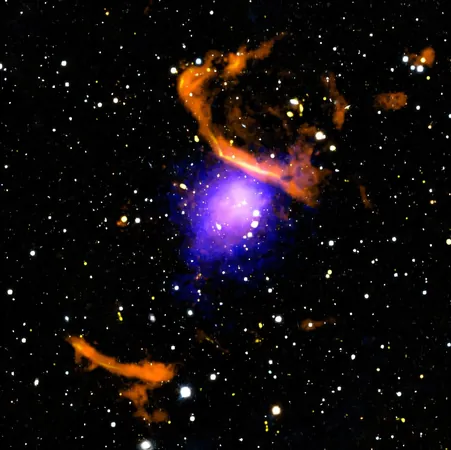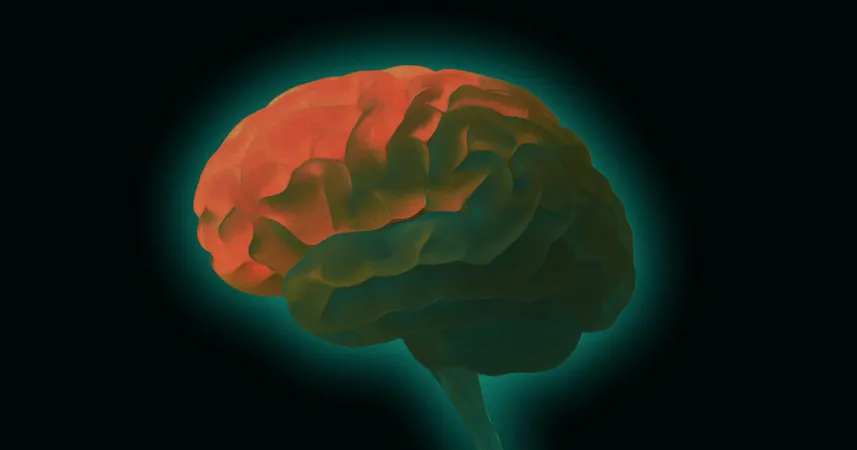
Astronomers Uncover a Record-Breaking Cosmic Structure: A Massive Particle Cloud Surrounding a Galaxy Cluster
2025-06-10
Author: Wei Ling
In an extraordinary astronomical breakthrough, scientists have discovered the largest known cloud of energetic particles encircling a galaxy cluster, stretching nearly 20 million light-years across. This finding sends shockwaves through established theories about how particles maintain their energy levels over cosmic timescales.
The groundbreaking study, led by experts at the Center for Astrophysics | Harvard & Smithsonian (CfA), was unveiled during a press conference at the 246th meeting of the American Astronomical Society (AAS 2025) in Anchorage, Alaska. The detailed findings have been submitted to The Astrophysical Journal and are also accessible on the arXiv preprint server.
Located an astounding 5 billion light-years away from Earth, the massive galaxy cluster PLCK G287.0+32.9 has fascinated astronomers since its discovery in 2011. Previous investigations identified two bright relics—impressive shockwaves illuminating the cluster's edges—but overlooked the sheer magnitude of faint radio emissions that fill the vast expanse between them. Recent radio imaging has unveiled a continuous glow enveloping the entire cluster, almost 20 times larger than our Milky Way, hinting at a far more powerful phenomenon at play.
"Initially, we anticipated finding just a bright pair of relics, consistent with earlier observations. Instead, we uncovered the entire cluster radiant in radio emissions," stated Dr. Kamlesh Rajpurohit, the lead author and Smithsonian astronomer at CfA. "The discovery of such an immense cloud of energetic particles is unprecedented in this cluster and any others. Previously, the largest recorded particle cloud, Abell 2255, measured approximately 16.3 million light-years."
Delving deeper into the cluster's core, the research team detected an astonishing radio halo approximately 11.4 million light-years in diameter—an unprecedented size for an observation made at a frequency of 2.4 GHz, where such halos are seldom visible. These revelations raise critical questions about the presence of cosmic ray electrons and the expansive magnetic fields, which seem to stretch to the very edges of the cluster.
Rajpurohit emphasized, "Typically, extensive radio halos are only observed at lower frequencies because the electrons generating them have aged and lost energy. Our discovery of a halo of this size signals active processes at work—potentially giant shockwaves or turbulence accelerating the electrons, although we're still piecing together the theories behind it."
This discovery opens new avenues for studying cosmic magnetic fields—one of astrophysics' most intriguing puzzles—providing deeper insights into how these fields influence the universe on monumental scales. "We are beginning to perceive the cosmos in ways never realized before," Rajpurohit added, underscoring the need to reassess how energy and matter traverse vast cosmic structures.
Furthermore, observations from NASA's Chandra X-ray Observatory have revealed fascinating features within the hot gas of the cluster, including box-shaped regions and comet-like tails. Some X-ray structures align with the identified radio signals, suggesting that substantial shocks and turbulence, possibly triggered by cluster mergers, are actively accelerating the electrons within this cosmic environment. Within the cluster's center, some peculiar features could stem from the merger of smaller galaxy clusters or violent outbursts from a supermassive black hole—or perhaps both.




 Brasil (PT)
Brasil (PT)
 Canada (EN)
Canada (EN)
 Chile (ES)
Chile (ES)
 Česko (CS)
Česko (CS)
 대한민국 (KO)
대한민국 (KO)
 España (ES)
España (ES)
 France (FR)
France (FR)
 Hong Kong (EN)
Hong Kong (EN)
 Italia (IT)
Italia (IT)
 日本 (JA)
日本 (JA)
 Magyarország (HU)
Magyarország (HU)
 Norge (NO)
Norge (NO)
 Polska (PL)
Polska (PL)
 Schweiz (DE)
Schweiz (DE)
 Singapore (EN)
Singapore (EN)
 Sverige (SV)
Sverige (SV)
 Suomi (FI)
Suomi (FI)
 Türkiye (TR)
Türkiye (TR)
 الإمارات العربية المتحدة (AR)
الإمارات العربية المتحدة (AR)